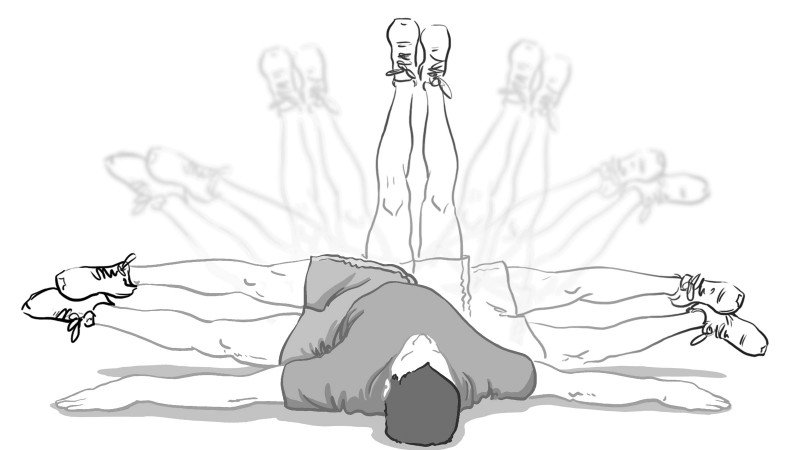After a strenuous MC Scow regatta, SailZing asked Ron Baerwitz, a high level sailor in various classes, and a dedicated stretcher, to comment on stretching for sailors. Here is Ron’s statement:
I am not a professional athlete. And neither is anyone else in our fleet. So why do weekend warriors think stretching is not important when pro athletes spend hours doing it? Sailing is the most physically strenuous thing I do, and I do a lot, including playing ice hockey. I get around the boat better, I get under the boom better, and I can hike longer when I stretch. AND, I feel less pain at the end of the day. After a hard day of sailing like the 4 races last Saturday I will spend 30-45 minutes stretching at night, sometimes with a foam roller. It makes a HUGE difference the next day.
Ron’s comments inspired us to seek further wisdom. We reviewed dozens of sources and found five insights that made us smarter about fitness and stretching for sailors. Maybe we’ll actually apply these insights in our preparation!
#1 – Keep Stretching Benefits in Perspective
The internet is full of widely varying claims for the benefits of stretching. Thankfully, there are also clinical studies refuting some of these claims. Here’s a summary of what we found.
Supported Claims
The studies and expert opinions all agree that stretching increases flexibility and joint range of motion. This leads to the following benefits:
- Makes range-of-motion tasks easier and less tiring (think hiking, twisting, bending, reaching, squatting)
- Enhances coordination and balance (think stability in the boat)
- Relaxes muscles that often accompany stress (who doesn’t need stress reduction during a race?)
- Improves posture (think fewer back problems)
Less Supported Claims
Clinical studies on stretching have shown mixed results or no benefits for the following:
- Improve recovery following exercise
- Prevent injuries
- Increase strength (at least in the short term)
These study results are summarized nicely in The Science of Stretching: Stretching and Strength, Speed, and Muscle Growth, an article in Muscle for Life.
#2 – Warm Up with Dynamic Stretching
Stretching cold muscles is like stretching a frozen rubber band. Dr. Robert Bray, in Sailing World
Most people associate stretching with static stretching, which is holding a challenging but comfortable position for a period of time. However, studies show decreased athletic performance immediately after static stretching. Fitness experts all recommend light dynamic stretching to get the blood flowing before a workout, competition, or any serious static stretching. Dynamic stretching also increases strength and agility, according to studies cited in The Science of Stretching: Stretching and Strength, Speed, and Muscle Growth.
#3 – Use Static Stretching to Develop Flexibility Over Time
Dynamic stretching is best for warmup. Conversely, studies such as in the Journal of Orthopaedic and Sports Physical Therapy, have shown that static stretching is best for developing flexibility over time. So, your best strategy is a continuing program of static stretching for flexibility, coupled with dynamic stretching for warmup prior to events (and before your stretching routines).
#4 – Recovery is a Mixed Bag
We’ve all heard weekend warriors complain about their bodies on Day 2 or 3 of a regatta. We looked for a consensus on how to speed recovery from a strenuous day of sailing. The best advice is to get in shape before the regatta. Beyond that, the weight of evidence shows varying levels of agreement on the following recovery aids.
Most Effective
- Sleep. No one disputes the value of nine or more hours sleep for recovery. If you need to be further convinced, read the 20-page Sleep Manual for Athletes, or get Tom Brady’s book, The TB12 method.
- Hydration. Again, there is consensus among the experts, who recommend getting hydrated before the workout, staying hydrated during, and maintaining hydration following. For a short review based on clinical studies, read Tom Brady (TB12 Method). After following his advice, I can personally attest to the recovery value of hydration.
May Be Effective or Have Psychological Benefit
“If it feels good, do it” might be the best way to describe the benefits of these techniques. There is no scientific consensus regarding their impact on actual next-day performance. However, they may work for some, and don’t discount the psychological benefit of doing something that feels good!
- Light activity and stretching. Keeps body fluids moving to remove waste.
- Massage and/or foam roller. Keeps fluids moving and releases tension in the myofascial layer, which is the connective tissue protecting your muscles. Here’s a summary article about foam rolling.
- Nutrition. Various studies recommend protein and foods high in anti-oxidants. We’ll cover nutrition in future posts.
- Anti-inflammatory medication (non-steroidal).
- Hot-cold immersion. This could be as simple as showering with alternating hot and cold water. Here’s the Wikipedia article, which concludes there may be some benefit to recovery.
#5 – Stretching for Sailors: Best Routines
We collected the most accessible demonstrations of stretching for sailors. There are many more out there.
- Dynamic stretching. Check out the Pre-Sailing Warmup and Stretches from the Australian Sailing Team.
- Static stretching. Here are Six Top Stretches for Racing Sailors from the Etchells Class website.
Related Content:
It’s spring, and time to start getting in shape for sailing season. Here are links to our previous fitness posts.
Top Sailing Fitness Principles and Exercises
Three Fitness Measures of Winning Sailors
Three Fitness Measures of Winning Sailors
Sailors Helping Sailors
Will you share your knowledge with your related Comments below?





